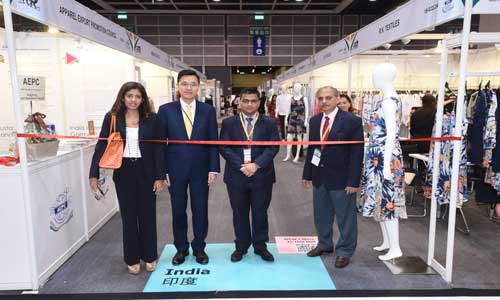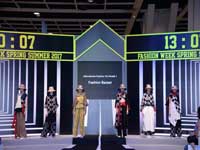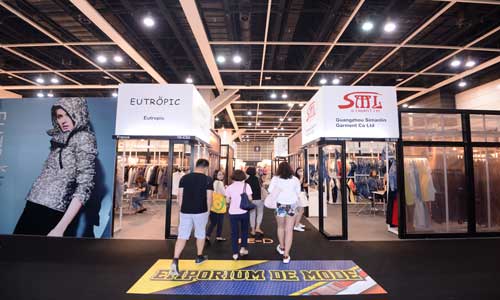FW
India has put up a strong presence at the ongoing Hong Kong Fashion Week from July 10 to 13, 2017. The Indian Pavilion has some 20 participants. Exhibitors are enthused and are keenly looking to the show. They feel there is a lot of elbow room for Indian exporters as long as they can harness their fundamental capabilities and strengths. Million Exporter is participating for the first time. This they are showcasing cotton and recycled polyester with a reasonable scale and consistency. They have also been able to provide garments at unbeatable prices and successfully exporting to Hong Kong and a few other

places in this part of the world. Indian manufacturers can capitalise on their primary strengths such as cotton garments and fashion looks to take on the competition. Hong Kong is a hub for exports to Mainland China, emerging Asean countries, Taiwan, Korea, Japan and even southern hemisphere countries.
About 1100 exhibitors from 20 countries and regions are taking part at the HKFW. There will be insights into latest market trends. These include a presentation by international trend forecasting group Fashion Snoops unveiling its autumn/winter 2018/19 fashion forecasts, a seminar jointly organised with the Hong Kong Research Institute of Textiles and Apparel on Wearable Technologies for Future Fashion, and a session with Woolmark sharing the latest technology applied in wool denim and wool sneakers.
Exporters in Tirupur want details about the tax implications of GST. The industry has numerous workers and units involved in different parts of the value chain such as printing, embroidery, washing, dyeing etc, which are taxed at 18 per cent while jobs related to yarn and fabric enjoy a five per cent rate.
They are still coming to terms with the new system and are caught between buyers and suppliers. Tirupur is India’s biggest knitwear hub and does exports of Rs 25,000 crores every year. At Tirupur, apart from the massive export orders, domestic knitwear sales amount to another Rs 12,000 crores.
Unlike exports, manufacturers don’t get input credit for domestic sales. So the 18 per cent tax for job works will have to be borne by the manufacturer, which naturally will raise the manufacturing cost and affect the fund flow. Manufacturers say that unless all the works are brought under a single slab of five per cent, they have no option but to pass it on to the consumer.
The industry was expecting a sales boost after the GST for readymade garments below Rs 1000 was fixed at five per cent. Higher cost of Tirupur garments may push big retailers turn to cheaper options in Bangladesh.
Islamic Fashion and Design Council (IFDC) launched a modest fashion category at Torino Fashion Week, Italy from June 26 to July 3, 2017. This was a first for a mainstream fashion week. The event was saw stylish modest fashion that rocked the runway as talented modest fashion designers mesmerized the mainstream fashion world.
Thirty IFDC designers showcased from over 23 countries. Islamic Fashion and Design Council is the world’s leading modest fashion and design council representing the Islamic economy and its stakeholders. IFDC, a leading advocate for modest fashion, art and design professionals and aspiring talent, has an array of products, services, and effective training programs for all levels.
Its platform is designed to ensure the success of modest fashion and design in the global marketplace. IFDC aligns itself with leading and budding mainstream and modest fashion and design brands, government organizations, institutions, corporations, media, global conferences, events, and fashion weeks to ensure a powerful, sustainable and supportive presence. With headquarters in the US, IFDC currently has offices in ten countries.
Torino Fashion Week brings together companies, fashion designers, agents, retailers and buyers, producers, distributors, brands and e-commerce agencies active in fashion and textiles to facilitate the creation of potential business and technological partnerships.
Egypt aims to double production of its most famous export, the silky soft cotton once known as ‘white gold’, after a period of slumping output. Production should rise to 1.4 million qintar (160 kg) in the 2017-18 fiscal that started in July from 700,000 qintar a year earlier. All the cotton will be exported. The government aims to increase the price of long staple cotton to more than 3000 Egyptian pounds ($168.07) per qintar, which will all be exported.
Egypt's sunny skies and superior seed help it grow cotton known for unusually long fibres that produce a light durable fabric with an attractive sheen and soft touch. Production, used in luxury bedding, has fallen sharply since 2011, a year of political upheaval that coincided with looser regulations that degraded the quality of local cotton. Long-staple sells at 155 US cents per lb, about twice the price of common short-staple cotton. Its return to world markets could provide a lucrative export opportunity at a time when Egypt has a huge trade deficit and is seeking to relaunch its stagnant economy.
In 2016, Egypt banned all but the highest quality cotton seed, dramatically shrinking the area under cultivation but restoring quality, in a bid to save its historic crop. This year Egypt grew about 220,000 acres (89,000 hectares) of long-staple cotton compared with 130,000 acres (52,600 hectares) in 2016-2107. Farmers, spinners, and exporters say the weakness of the Egyptian pound following its flotation in November and a scandal over the alleged sale of falsely labelled Egyptian cotton have increased demand for the real thing, injecting life into a historic industry on its deathbed.
Cambodia is the fifth biggest supplier of garment and textile products to the European Union. It’s behind China, Bangladesh, Turkey and India. Cambodia’s garment exports to the EU grew 14 per cent in 2016. EU market growth was largely as a result of preferential treatment under the ‘Everything But Arms’ (EBA) agreement, which allows garment products to enter the EU market duty-free due to its status on the list of least developed countries.
The EU’s Everything But Arms arrangement (EBA) was born in 2001 to give LDCs duty-free and quota-free access to the EU for all their exports with the exception of arms and armaments. This makes it the most generous form of preferential treatment to LDCs globally. There are currently 49 beneficiaries under this arrangement.
Entry into the EBA is automatic and, unlike other GSP arrangements, the EBA has no time-limit. With the per capita income of Cambodia already surpassing the middle income economy’s threshold, sooner or later Cambodia will lose its LDC status as classified by the United Nations. Once Cambodia loses this status, it will surely affect the garment industry. Therefore Cambodia will have to diversify its economic foundations as well as increase its productivity.
Many global brands are finding that the Vietnam allure of cheaper overheads, lower labor costs and reduction in taxes isn’t really a profitable option for them over the long term. So they are increasingly seeing less benefit from outsourcing and are moving back to the direct to customer model.
The number of manufacturers selling directly to customers is expected to grow 71 per cent in 2017 to more than 40 per cent of all manufacturers. And over a third of US consumers bought directly from a brand manufacturer’s website last year. The textile and clothing segment in Vietnam could find themselves shrinking over the next decade if the transformation away from strictly outsourcing to the direct to customer model isn’t adopted.
Only a small portion of clothing produced in the Southeast Asian country is fabricated from materials sourced in the country. This needs to increase significantly. Boosting localization in the segments is a prerequisite to benefit from free trade agreements such as the Viet Nam-EU pact, which comes into force in 2018.
Vietnam needs to shift away from manufacturing low end products to creating innovative, quality, high value manufactured items and fashionable clothing. Also more efficient sourcing through vertical integration is essential, as well as an improvement in productivity by enhancing research, training and development.
Textile workers in Bhiwandi — weavers, technicians, daily wagers and laborers — have been hit hard by the implementation of GST. Textile units are shutting down. There is no yarn available amid the chaos around GST. Bhiwandi is one of India’s largest textile hubs. The industry, which had always been exempt, is reeling from the impact of being brought under the new tax regime.
Burdened by unsold stock, weavers have stopped operations. Over the past 20 days, around five lakh power looms are idle in Bhiwandi. Weavers, technicians and workers from Bihar, UP, West Bengal and Orissa form a large part of the workforce in Bhiwandi. Workers usually come with targets to earn a certain sum to pay off a loan or for a daughter’s wedding. Since there is no work, they have started leaving.
Under the new tax regime, master weavers have to pay taxes for buying yarn — 18 per cent on manmade fiber yarn and five per cent on cotton yarn. This is apart from a five per cent tax on services. If loom owners pay five per cent on each of the ten services in our looms, their manufacturing cost will increase by over 15 per cent. This will not be set off by the tax levied on the product and they will have to bear the extra cost.
Seek the progressive, contemporary fashion trade show was held in Germany from July 4 to 6, 2017. The show presented more than 250 brands across men’s wear, classics, women’s wear, authentic designer collections, lifestyle products and street wear.
Since 2009, the show has presented its ever-growing audience with new labels, and re-introduced old brands to new customers. Its biannual shows are focused on modern clothes for independent minds.
Seek offers brands and visitors a sophisticated and relaxed environment for both business and pleasure. The aim is to both inspire and be inspired. Exhibiting brands showcase a mixture of new attitudes and old traditions - but are always committed to authentic products in high quality, produced independently. Especially striking was the strong cluster of retro sportswear brands. Seek offered lots of different options to choose from – from smaller names such as Danish H2O to the various different lines by Champion.
Street and footwear brands such as Suicoke, The North Face Red, Airwalk Classics made their debut. Big German buyers were spotted. Also, many classic oriented men’s wear buyers found their way to Seek to look for inspiration. The show placed an emphasis on autonomy, anti-trend sentiment, tradition and provenance, shaped by subcultures, music, art and film.
"The 24th Hong Kong Fashion Week for Spring/Summer opened today at the Hong Kong Convention and Exhibition Centre and will run until July 13. Organised by the Hong Kong Trade Development Council (HKTDC), the show gathers nearly 1,100 exhibitors from 20 countries and regions, serving as an ideal one-stop sourcing platform for the industry. Exhibits feature the latest fashion designs, international brands, garments, fabrics and accessories."

The 24th Hong Kong Fashion Week for Spring/Summer opened today at the Hong Kong Convention and Exhibition Centre and will run until July 13. Organised by the Hong Kong Trade Development Council (HKTDC), the show gathers nearly 1,100 exhibitors from 20 countries and regions, serving as an ideal one-stop sourcing platform for the industry. Exhibits feature the latest fashion designs, international brands, garments, fabrics and accessories.
Under the theme ‘Style in Motion’, 20 fashion events will be held at the fair, including fashion shows, trend forecasting seminars, buyer forums and a networking reception, presenting the latest market intelligence and fashion items. This year’s show will also feature new exhibitors from Canada, Nepal, Saudi Arabia and Vietnam; along with eight pavilions from India, Indonesia, Japan, Macau, Thailand, and first-timers Italy, Korea and Nepal.
Fashionable Sportswear zone debuts

Reflecting global trend towards athleisure this year’s Fashion Week for Spring/Summer opens the new Fashionable Sportswear and Urban Clothing zones to help buyers easily locate relevant products and suppliers. Other zones catering to specific industry interests include the Fashion Gallery, featuring a wide array of high fashion items; the International Fashion Designers’ Showcase, gathering exquisite collections of global fashion designers; as well as the diverse womenswear and Fabrics & Yarn zones. To help buyers easily find their sought-after products, the HKTDC is housing all fashion accessories-related zones, including footwear, leggings & socks and gloves, scarves shawls, in the inaugural World of Fashion Accessories section. In addition, the show has once again set up a Small Orders zone, featuring nearly 100 showcases and garment racks with about 400 products available for orders in minimum quantities of between five and 1,000 pieces.
Meanwhile, at the new Urban Clothing zone, an Italian exhibitor is displaying a range of locally designed and manufactured casual denim wear, while the Italian Trade Commission Hong Kong and Assocalzaturifici are showcasing 50 styles of Italian shoes under the theme ‘The Seduction of Footwear: Italian Glamour’. Experts from trend forecasting agency WGSN will share the upcoming season’s footwear trends tomorrow.
New launches
At the Fabrics & Yarn zone, The Woolmark Company is featuring its new Wool Denim, which apart from being anti-odour, also provides better warmth retention than normal denim and is machine-washable. The company will also host a seminar titled ‘New Generation of Merino innovation – Wool Denim Wear & Wool Sneakers’ tomorrow morning. Other exhibitors include the Japanese sports brand Sangacio, which has incorporated precise manufacturing techniques from Kobe with Italian Florentine design, selecting the finest cow leather to produce handcrafted sports shoes. Besides, Hong Kong exhibitor Titane Group (Hong Kong) Ltd has taken inspiration from the rims of sports cars to manufacture a series of delicate interchangeable cufflinks for matching different styles.
To create more business opportunities for exhibitors, the HKTDC has organised 90 buying missions, bringing more than 5,000 buyers from 45 countries and regions to the show. They include representatives of renowned fashion labels, mega chain stores and major distributors, such as the Czech Republic’s Zoot, Germany’s Unito Fashion, Japan’s Isetan, Russia’s Melon Fashion Group, Taiwan’s Keraia, Thailand’s The Mall Group, and the United Arab Emirates’ Just Lounge.
Fashion trends and market drivers
A series of seminars and forums will be held during the show, including a presentation by international trend forecasting group Fashion Snoops on their Autumn/Winter 2018/19 fashion forecasts, and a seminar jointly organised with the Hong Kong Research Institute of Textiles and Apparel (HKRITA) on ‘Wearable Technologies for Future Fashion,’ where four experts will share their thoughts on knitting technologies, health concerns and quality of wearable technologies. On Wednesday, a seminar titled ‘Tips on Marketing Your E-tailing Business’ will feature seasoned industry experts discussing marketing strategies for online sales, while a ‘Testing and Certification Services for Textiles and Garments’ seminar will also be held on the same day.
Talented designers present their latest works
During the fair, a number of runway shows will be staged, including fashion parades by local fashion design graduates, allowing them to demonstrate their talent on the Fashion Week stage. Tomorrow, students from the Chinese University of Hong Kong’s School of Continuing and Professional Studies will stage their graduation parade. The Hong Kong Polytechnic University will also host a graduate fashion show and lingerie show tomorrow and on Wednesday, while the Technological and Higher Education Institute of Hong Kong will stage a graduation show tomorrow.
New designs are launched at Fashion Week shows, with Indonesian brand Neusa by Purana unveiling its latest collection blending traditional Indonesian fabric with modern designs at this morning’s international fashion parade. Another parade today spotlights a new exhibitor from Saudi Arabia, showcasing its latest ethnically rich designs. In addition, Macau brand Chavin and the Macau Productivity and Technology Transfer Centre will host international fashion parades on Wednesday, with Chavin featuring its evening wear and wedding gown series under the theme of ‘Nouvel Collection’.
Silverman Holdings, based in China, wants to sell its fabric subsidiary and give focus on its film and television business. Rising challenges facing the textile industry in China is one of Silverman’s main reasons in letting go of its fabric business. The company also plans to change its name to Starrise Media Holdings.
Over the recent years, the textile industry in China has faced various challenges, including increasingly fierce competition, rising domestic production costs, and weakening market demand for textiles both within and outside China.
Silverman is engaged in the design, manufacture and sale of high-end home textile and apparel fabrics and fabric products using a wide spectrum of functional, differentiated and new fibers such as cotton, milk fiber, soybean fiber, bamboo fiber, among others. The group has 1,000 sets of advanced weaving machines including more than 250 sets of high speed jacquard looms. The annual fabric production capacity is 80 million meters.
Its principal products are jacquard fabrics and dobby fabrics. It also provides processing services for fabric products to certain customers. Silverman is committed to ensuring continued innovation, improving management, achieving efficiency and enhancing brand image. It will continue to actively seek out new development opportunities and will strive to generate a healthy profit and return for shareholders.











